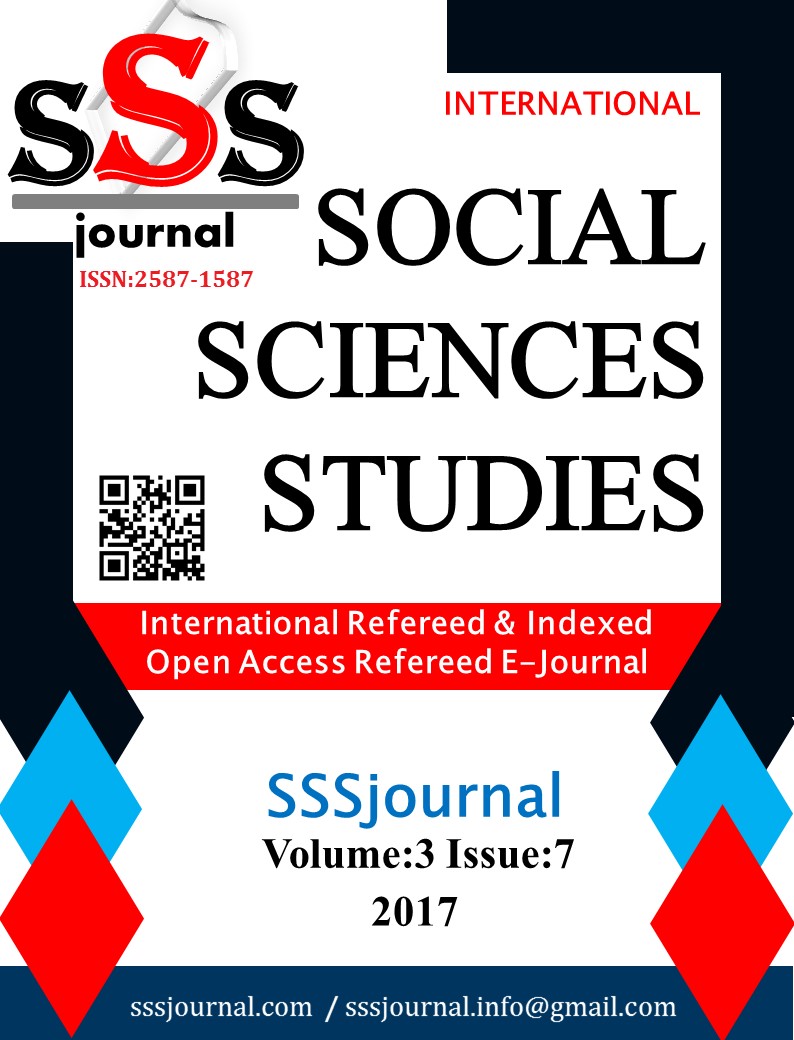Author :
Abstract
Bu çalışmanın amacı, bireylerin geçmişteki olumlu ya da olumsuz yaşantılarını ne derece genel olumlu bir temsile dönüştürebildiğini değerlendirmek amacı ile 1994 yılında Santor ve Zuroff tarafından geliştirilmiş olan Geçmişi Kabul Etme Ölçeği’nin (GKÖ) ve araştırmacılar tarafından bu ölçeğin ayırt edici geçerliğini test etmek amacıyla geliştirdikleri Geçmişi Anımsama Ölçeği’nin (GAÖ) Türkçe’ye uyarlamasını yapmaktır. Bu amaçla, farklı yaş gruplarıyla iki ayrı araştırma yapılmıştır. İlk çalışmanın örneklemini 17-28 yaş diliminde bulunan, 183 (94 kadın, 89 erkek) katılımcı oluşturmuştur. Bu çalışmada, GKÖ’nin yapı geçerliğini test etmek amacı ile GAÖ ile GKÖ’nin maddeleri birlikte faktör analizinden geçirilmiş ve geçmişi kabul etme ve geçmişi anımsamanın iki ayrı kavramsal yapı olduğu gözlenmiştir. Ölçeklerin güvenirliği incelendiğinde GKÖ .85 ve GA ise .74 düzeyinde bir iç tutarlılık değeri göstermiştir.
İkinci çalışmada 55 yaş ve üstü yetişkinlerde GKÖ ve GAÖ’nin psikometrik özellikleri incelenmiştir. Bu araştırmaya 45 kadın, 33 erkek olmak üzere 78 kişi katılmıştır. GKÖ’nin ayırt edici geçerliği incelendiğinde, GKÖ ve GAÖ arasındaki korelasyon özgün çalışmada olduğu gibi anlamsız bulunmuştur. GKÖ .84; GAÖ ise .69 düzeyinde bir iç tutarlılık göstermiştir. Her iki çalışmada da GKÖ’nin maddeleri üzerinde yapılan faktör analizleri GKÖ’nin ayrıca iki faktörlü yapısının da sağlıklı bir dağılıma sahip olduğunu, buna göre Olumlu ve Olumsuz Geçmiş Temsili olmak üzere iki faktörlü şekilde de kullanıma uygun olduğunu göstermiştir. Bulgular, GKÖ ve GAÖ’nin Türk örneklemi için yeterli geçerlik ve güvenirlik değerlerine sahip olduğunu desteklemektedir.
Keywords
Abstract
The purpose of the present study is to adapt the Accepting the Past Scale (ACPAST) developed by Santor and Zuroff (1994) to investigate in what extent the individuals may integrate both positive and negative experiences into general positive mental representations and the Reminiscing about the Past Scale (REMPAST) developed with the aim of testing discriminant validity of the ACPAST. 183 (94 women, 89 men) persons aged between 17 and 28 participated in Study 1. The factor analysis performed on the items from the ACPAST and the REMPAST supported construct validity of the ACPAST. Internal consistency levels were .85 for the ACPAST, and .74 for the REMPAST.
A second study was conducted with a sample of 78 (45 women, 33 men) aged 55 years or older to investigate the psychometric properties of the scales. When discriminant validity of the ACPAST was examined, the correlation between ACPAST and REMPAST was found insignificant as in the original study. Internal consistency levels were observed as .84 for the ACPAST and .69 for REMPAST. In both studies, the factor analyses on the ACPAST indicated that two-factor solution is also healthy for the ACPAST and the scale is suitable for the use with two dimensions named Positive and Negative Past Representations. Results demonstrated that the ACPAST and the REMPAST have satisfactory level of reliability and validity on Turkish samples.
Keywords
- Boyacıoğlu, İ. ve Sümer, N. (2011). Bağlanma boyutları, otobiyografik bellek ve geçmişi kabul etme.
- Boyacıoğlu, İ. ve Sümer, N. (2011). Bağlanma boyutları, otobiyografik bellek ve geçmişi kabul etme. Türk Psikoloji Dergisi, 26, 105-118.
- Burroughs, H., Lovell, K., Morley, M., Baldwin, R., Burns, A. ve Chew-Graham, C. (2006).Justifiable depression: How primary care professionals and patients view late-lifedepression? A qualitative study. Family Practice, 23, 369–377.
- Butler, R. N. (1963). The life-review: An interpretation of reminiscence in aged. Psychiatry, 26, 65-Courtois, C. A. (2004). Complex trauma, complex reactions: Assessment and treatment. Psychotherapy: Theory, Research, Practice, Training, 41(4), 412-425.
- Davidhizar, R. E. ve Lonser, G. (2002). When the health care manager is preoccupied with self-doubt. Health Care Manager, 21(2), 29-35.
- Erikson, E. H. (1963). Childhood and society. New York: Norton.
- Garro, L. C. (2001). The remembered past in a culturally meaningful life: Rembering as cultural,social and cognitive process. In H. Matthews and C. Moore (Eds), The psychology of cultural experience. Cambridge: Cambridge University Press.
- Haight, B. K. ve Haight, B. S. (2007). The handbook of structured life review. Baltimore, MD, US: Health Professions Press.
- Hope, D. (1987). The healing paradox of forgiveness. Psychotherapy, 24(2), 240-244.
- Howard ve Glenn (2009). Assessing positive life change: In search of meticulous methods. In C.LPark, S.C. Lechner, M.H. Antoni, A.L. Stanton, (Eds), Medical illness and positive life change: Cancrisis lead to personal transformation?. Washington, DC, US: American Psychological Association. Lecci, L., Okun, M. A., & Karoly, P. (1994). Life regrets and current goals as predictors
- of psychological adjustment. Journal of Personality and Social Psychology, 66(4), 731-741.Murray, J., Banerjee, S., Byng, R., Tylee, A., Bhugra, D. ve Macdonald, A. (2006). Primary careprofessionals' perceptions of depression in older people: a qualitative study. Social Science & Medicine, 63(5), 1363–1373.
- Oladinni, O. (2002). A survey of inner London general practitioners' attitudes towards depression. Primary Care Psychiatry, 8(3), 95–98.
- Santor, D. A. ve Zuroff, D. C. (1994). Depressive symptoms: Effects of negative affectivity and failing to accept the past. Journal of Personality Assessment, 63(2), 294-312.
- Tedeschi, R. G. ve Calhoun, L. G. (2004). Posttraumatic growth: Conceptual foundations and empirical evidence. Psychological Inquiry, 15(1), 1-18.
- Westerhof, G. J., Bohlmeijer, E. ve Webster, J. D. (2010). Reminiscence and mental health: A review of recent progress in theory, research and interventions. Aging & Society, 30(4), 697-721.
- Wong, Y. J. (2006). Strength-centered therapy: A social constructionist, virtues-based psychotherapy. Psychotherapy: Theory, Research, Practice, Training, 43(2), 133-146.
- Wong, P. T. P., ve Fry, P. S. (1998). Introduction. In P. T. P. Wong, & P. S. Fry (Eds), The humanquest for meaning: A handbook of psychological research and clinical applications. Mahwah, NJ, US: Lawrence Erlbaum Associates Publishers.
